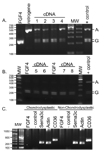An expressed fgf4 retrogene is associated with breed-defining chondrodysplasia in domestic dogs
- PMID: 19608863
- PMCID: PMC2748762
- DOI: 10.1126/science.1173275
An expressed fgf4 retrogene is associated with breed-defining chondrodysplasia in domestic dogs
Abstract
Retrotransposition of processed mRNAs is a common source of novel sequence acquired during the evolution of genomes. Although the vast majority of retroposed gene copies, or retrogenes, rapidly accumulate debilitating mutations that disrupt the reading frame, a small percentage become new genes that encode functional proteins. By using a multibreed association analysis in the domestic dog, we demonstrate that expression of a recently acquired retrogene encoding fibroblast growth factor 4 (fgf4) is strongly associated with chondrodysplasia, a short-legged phenotype that defines at least 19 dog breeds including dachshund, corgi, and basset hound. These results illustrate the important role of a single evolutionary event in constraining and directing phenotypic diversity in the domestic dog.
Figures




Comment in
-
Genetics. More than just a copy.Science. 2009 Aug 21;325(5943):958-9. doi: 10.1126/science.1178487. Science. 2009. PMID: 19696341 No abstract available.
References
-
- Wayne RK, Ostrander EA. Trends Genet. 2007 Nov;23:557. - PubMed
-
- Kirkness EF, et al. Science. 2003;301:1898. - PubMed
-
- Cruz F, Vila C, Webster MT. Mol Biol Evol. 2008 Nov;25:2331. - PubMed
-
- Stockard CR. The Genetic and Endocrinic Basis for Differences in Form and Behavior. Philadelphia: The Wistar Institute of Anatomy and Biology; 1941.
Publication types
MeSH terms
Substances
Grants and funding
LinkOut - more resources
Full Text Sources
Other Literature Sources

